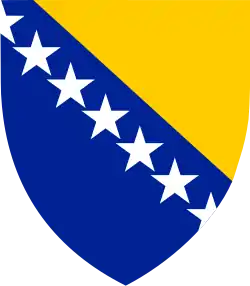Zenica
Zenica (/ˈzɛnɪtsə/ ZEN-it-sə; Serbo-Croatian Cyrillic: Зеница; Serbo-Croatian pronunciation: [zěnitsa] (![]() listen)) is a city in Bosnia and Herzegovina and an administrative and economic center of the Federation of Bosnia and Herzegovina's Zenica-Doboj Canton. It is located in the Bosna river valley, about 70 km (43 mi) north of Sarajevo. The city is known for the Ironworks Zenica and the second heavy industry but also as a significant university center. According to the final results of 2013 population census in BiH, the settlement of Zenica itself counts 70,553 citizens and the administrative area 110,663.[5]
listen)) is a city in Bosnia and Herzegovina and an administrative and economic center of the Federation of Bosnia and Herzegovina's Zenica-Doboj Canton. It is located in the Bosna river valley, about 70 km (43 mi) north of Sarajevo. The city is known for the Ironworks Zenica and the second heavy industry but also as a significant university center. According to the final results of 2013 population census in BiH, the settlement of Zenica itself counts 70,553 citizens and the administrative area 110,663.[5]
Zenica
Зеница | |
|---|---|
| Grad Zenica City of Zenica | |
.jpg.webp) Zenica, collage From top to bottom, left to right: Bilino Polje Stadium, Old Čaršija, Fortress Vranduk, čaršija (by the bazaar), old bazaar and Kočeva mosque, panorama with the view on river Bosna, settlements Jalija and Bilimišće, and Krč rocks | |
| Etymology: from Proto-Slavic zěnica ("pupil") | |
| Nickname(s): | |
 Location within BiH (City) | |
 Zenica Location within BiH (city) | |
| Coordinates: 44°12′14″N 17°54′28″E | |
| Country | |
| Entity | |
| Canton | Zenica-Doboj |
| Earliest findings | 3,000–2,000 B.C. (Drivuša, Gradišće) |
| First name | 2nd–4th century (Bistua Nuova) |
| Current name | 1415 or March 1436 (Zenica) |
| 1st Mayor | before 1908 (Ahmetaga Mutapčić) |
| Municipality became City | 20 November 2014 (Zenica City) |
| Government | |
| • Body | Council |
| • Mayor | Fuad Kasumović (Ind.) |
| Area | |
| • City | 558.5 km2 (215.6 sq mi) |
| • Urban | 43.01 km2 (16.61 sq mi) |
| Elevation | 310–350 m (1,017–1,148 ft) |
| Population (2013) | |
| • City | 110,663 |
| • Density | 200/km2 (510/sq mi) |
| • Urban | |
| Demonym(s) | Zenican (Serbo-Croatian: Zeničanin / Зеничанин) |
| Time zone | UTC+1 (CET) |
| • Summer (DST) | UTC+2 (CEST) |
| Postal code | BIH-72 000 (for whole Zenica City, including Zenica city) BIH-72 100 (for Zenica city only as settled place) |
| Area code(s) | +387 32 |
| Website | www |
The urban part of today's city is formed in several phases, including Neolithic, Illyrian, Roman Municipium Bistua Nuova (2nd–4th century; old name of the city) with early Christian dual basilica. Traces of an ancient settlement have been found here as well; villa rustica, thermae, a temple and other buildings were present too. Earliest findings in the place date from the period 3,000–2,000 B.C.; they were found on the localities of Drivuša and Gradišće. Zenica's current name was first mentioned in 1415. Medieval church has been unearthed in Zenica, as well as Franciscan Monastery of St. Mary. Time of the independence of the Medieval Bosnia is directly connected to Zenica (Gradješa's plate and abdication act; Kulin ban's time; Vranduk, a castle of the Bosnian kings; Janjići and 'hižas' [homes] of the Bosnian Church members; stećci, stone tombstone monuments etc.). During the Ottoman rule (1463–1878), Zenica became a Muslim town (kasaba); at the very end of the 17th century, Zenica had 2,000 citizens, mostly Muslims; Orthodox and Catholic Christians get mentioned again from the end of the 18th century, and Jews in the 19th century. Zenica has been mostly built in the Austro-Hungarian and Yugoslavian periods. The population rose rapidly during the 20th century, and from the Bosnian War until 2013 city lost a quarter of its population. Municipality of Zenica became the City of Zenica in 2014.
The city is geographically located in the heart of Bosnia. Area of the settled place is 43.01 km2 (16.61 sq mi) and of the City 558.5 km2 (215.6 sq mi). The relief is valley-basin and the elevation 310–350 m (1,017–1,148 ft). Rivers Bosna, Lašva, Babina and Kočeva flow through the city itself. The moderate continental climate prevails. The city has 13 urban local settlements and the City consists of total 81 spread rural settlements.
The city has nine national monuments. The football club Čelik is a landmark of Zenica, as is one of the tallest buildings on the Balkans – Lamela. Some of the most famous Zenicans are Semir Osmanagić, Anabela Basalo, Danis Tanović, Amar Jašarspahić Gile, Mladen Krstajić, Dejan Lovren, Mervana Jugić-Salkić and Amel Tuka.
Etymology
.jpg.webp)
There are several theories about the name.
- Tradition and legend
According to the orally transmitted tradition, the city was named after the pupil of the eye (ekavian Serbo-Croatian: zenica – pupil).
The legend of the name is connected to the saddest period of the medieval Bosnian state and Croat people on the Balkans: the fall of the Bosnian Kingdom to the Ottomans in 1463. According to the folk stories of Catholic Croats, there is a legend that Zenica's name is derived from when Queen Katarina Kosača Kotromanić was leaving Bobovac and said, "My pupil is left behind!" (Serbo-Croatian: Osta moja z[j]enica!)[6]
Because of its location in the center of Zenica field, the city is indeed analogous to the eye pupil.[7]
Name of the city can also be derived from the word zenit, because the city is in the center of Bosnia and Herzegovina i.e. Bosnia.
History
![]() Austro-Hungarian Empire 1878–1918
Austro-Hungarian Empire 1878–1918
![]() State of Slovenes, Croats and Serbs 1918
State of Slovenes, Croats and Serbs 1918
![]() Kingdom of Serbs, Croats and Slovenes 1918–1929
Kingdom of Serbs, Croats and Slovenes 1918–1929
![]() Kingdom of Yugoslavia 1929–1941
Kingdom of Yugoslavia 1929–1941
![]() Independent State of Croatia 1941–1945
Independent State of Croatia 1941–1945
![]() SFR Yugoslavia 1945–1992
SFR Yugoslavia 1945–1992
![]() Republic of Bosnia and Herzegovina 1992–1997
Republic of Bosnia and Herzegovina 1992–1997
The urban part of the today's Zenica formed through several determined phases which chronologically include the time of Neolithic community, Illyrian 'gradina', Roman Municipium Bistua Nuova, the most important founding (2nd–4th century) in which the monumental early Christian basilica is mostly present, besides which only one other is identified in the Europe.
In the city Zenica's settlement of Bilimišće, traces of ancient settlement were found;[8][9] in the City of Zenica's villages Putovići and Tišina, where villa rustica dominates, thermae, temple and a series of other following objects are present, too.[8][9][10]
Prehistory
Earliest findings in the Zenica place date from the period 3,000 B.C. to 2,000 B.C.;[7] they were found on the localities of Drivuša and Gradišće.[7] The following findings are from the Metal Age in Orahovički stream near Nemila, Gračanica, Ravna and other places;[7] metal axes, arrows, ornamental fibulae and ceramic remains were unearthed here.[7]
Illyrians came to this region on the transition from Bronze to Iron Age (from 6th to 5th century B.C.).[7] Their defensive buildings 'gradinas' are the most famous (the name came from the verb – Serbo-Croatian: graditi – to build).[7]
The urban part of today's Zenica has already formed in the younger Stone Age – Neolithic, and especially later in the time of Illyrians – today, toponyms of their 'gradinas' are proof for that:[7] Gradišće, Gračanica, Gradac.[7] A specific locality 'Gradina' in Kopilo village indicates that Zenica and surrounding farther places had organized prehistoric human life about 2,000 years B.C.[11] There is a weak[11] question of the presence of the Illyrian Old-Balkan tribe Daesitiates in Zenica region.[7] Solution can be direct proofs from toponomastic material – such as the toponym 'Gradina' which survived until today in the names of the mentioned settlements Gradac, Gradišće and Gračanica.[7] Daesitiates are a result of ethnic-social development of the mentioned early human life in prehistory; the transition period from the Bronze to the Iron Age resulted with Daesitiates emerging at the Lašva–Drina rivers belt. The tribe Daesitiates confronted the Romans in 34 B.C.; the Romans did not make a long-lasting triumph, and the Illyrians were defeated in the city of Arduba, which was burnt down in 6–9 A.C.[11] That is how the royal city of Vranduk probably existed in the time of Illyrians, under the name Arduba.[7][11]
Recent (August 2019) international archaeological research, conducted by the Vienna (Institute for Oriental and European Archaeology), Zenica (Zenica museum) and Sarajevo students and scientists using modern technology, shows that settlements with people and animals were near Zenica over 3,100 years ago.[12] Skeletons of pigs, cattle, and goats were found in Kopilo, an elevated place (600 m a.s.l.), indicating that humans (farmers) then lived there; two tombs (one with human bones and ceramics), two tumuli and a completely new prehistorical settlement 'Ravna gradina' were found, too.[12][13][14][15]
Old Age
Romans had tried to conquer these parts from the very end of the 3rd century B.C. Bellum Batonianum from 6th to 9th century was present in this area too. The Romans ruled continuously in many areas almost until the end of the 4th century (after Arduba's fall).[11] Roman authority did not remove (i.e. rebuild, change) settlements in the Illyrian 'gradinas'.[7]
Today's area of Zenica had its peak in the first six centuries of the new era, when in parts of today's Zenica – aside from Bistua Vetus (the barbarians' village in Rama) and Delminium (Duvanjsko Field) – one of the three most important municipiums and centers of Christian dioceses in Bosnia has been found: Bistua Nuova – seat of the Bistuenska diocese,[16] the seat of Roman Christianity in the Bosnian area prior to the Slavs' arrival.[17] Information that Bistua Nuova's bishop Andrew (Andreas, Andrija) took part in and was a signer of Solin sinodas in 530 and 533 underlines its importance. Ancient tombstone monuments are from ancient Bistua Nuova, as well as remains of old Christian basilica etc.[16] In the urban settlement of Odmut, and rural settlements of Putovići and Tišina, archaeologists found various findings; epigraphs stand out by their importance, which guided them towards the conclusion that Bistua Nuova was in the Zenica area.[7] It is not excluded that Bistua Nuova was right at the place of today's Zenica,[17] and/or was just named municipium Bistua Nuova.[11] Anyway, the Zenica region was known settlement at this point in the history, as numerous proofs of Roman-era Zenica exist.[11]
An important road towards Salona (Solin), Argentarium (Srebrenica) and Sirmium (Srijemska Mitrovica) was passing through Bistua Nuova.[6]
Barbarian invasions from the north (mainly Germans at the end of 3rd century, as well as Slavs later)[11] stopped civilization continuity and shortly forced Christianity to retreat from these areas. During the invasions, at the beginning of the 7th century, Bistua Nuova was destroyed, along with its basilica. Four centuries of emptiness in the wells follow after the retreat of Christianity.[6] It is believed that the barbarian invasions destroyed a huge part of the ancient inheritance. Goths, Avars and Slavs passed through this location. Slavs came in 6th and 7th centuries, and inhabited the middle part of Bosna river stream – where Zenica Field is located, site of some of the most important historic events of medieval Bosnia; these Slavs formed tribal communities and were organized into a tribal ruling unit called a 'župa' (parish).[11] After their invasions, almost one century was needed for first Slav countries to form.[7]
Medieval Bosnia
The history of medieval Zenica is not well recorded.[8][9] There is but a single item of evidence from 1244 about Croatian-Hungarian king Béla IV's charter. According to the documents that have been studied until so far, the city's current name was first mentioned on 16 March 1436[11] (or 20 March 1436,[8][9][10] annually celebrated as 'Zenica Day') and later – Zenica is mentioned in a series of documents related to Republic of Ragusa (Republic of Dubrovačka).[10][8] Among other Bosnian parishes, Bored parish, which includes the place "Bilina poila" is mentioned in the charter; the place refers to one part of the town Zenica, today well known Bilino polje.[11] The same place is mentioned in another document, dated 8 April 1203; it records a group of Bogomil chiefs who renounced paternalism before Innocent III's court chaplain John of Casamaris.[11] Bogomilism's presence in the Zenica area and its status as a seat of the Bogomil Church is supported not only by written documents but also by headstones which illuminate the Church's hierarchy.[11]
In the period of Middle Ages, in 1370 more precisely, settlement Klopče was mentioned, as well as family of that name; on 8 January 1404, the Bosnian bishop from Janjići sent dispatches to the Ragusan prince Vlaho Sorkočević. In the Zenica settlement of Varošište, a medieval church has been unearthed and Franciscan monastery of St. Mary, which was built by sculptor Ivan Hrelić, a student of Juraj Dalmatinac.[10][8]
Time of the political independence of the Middle Ages Bosnia is directly connected to Zenica, before all with Gradješa's plate and act of abjuration, by which Kulin ban's time was continued and it denotes facts of political power, too. Near the fortified city of Vranduk, the seat of Bosnian kings, Janjići and homes of the bishops of the Bosnian Church, with stećci in Puhovac and Pojske, several scribes and builders – among other – are the facts and proofs of a special significance of this place in the Middle Ages. Also with its names (Bistua Nuova, Bilino polje, Brod) – and Zenica after March 1436, this city is tied for central part of the country and river Bosna.[10][8]
Ottoman era
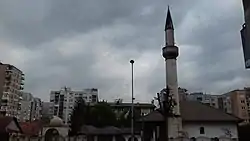
Bosnia had suffered Ottoman incursions, starting in 1386. The first Turkish entry into Zenica relates to their win over Hungarian warriors near Doboj in 1415.[11] Zenica has been mentioned under today's name since that event.[11] The first official record of the city's name is in the document dated 16 March 1436;[11] the document relates to the invasion and robbery of Hum done by the Ottoman Duke Barak who retreated towards Zenica and there received Ragusan money in the name of redemption.[11] Since that event until complete establishment of Ottomans in Bosnia (1463) there are no obtainable mentions of Zenica in relevant documents; that is a reason why this era in the city's history cannot be reasonably covered in detail.[11]
After administrative changes introduced in the first years of the rule, Zenica became part of Brod kadiluk in the newly formed Sanjak of Bosnia. Nahya of Zenica was first mentioned in 1485; it bore that name until the end of 18th century; it later became Zenica srez but had still been mentioned as nahya in Ottoman documents as Zenica was the most important place of Brod in 18th and 19th centuries.[11]
In the times of Ottoman rule (1463–1878), the change of the direction of the main trade route[11] in turn changed the city[8][9] and except for a short period when it was a seat of Brod judge 'kadija' (until 1557) Zenica was a kasaba (small town),[11] again with characteristic lookalike made by several mosques (Sultan Ahmedova, known as Čaršijska camii, too; Osman-Čelebijina; Sejmenska; Jalijska), Madrasah (1737), several maktabs, various nishans (a type of Bosnian Muslim gravestone), shadirvans, inns, caravansaries, etc.[10][8]
In one description from 1697 Zenica is discussed – where melons grow successfully "and whole place is very tame". According to the presumptions, Zenica had 2,000 citizens, among which Muslims dominated; at the end of 18th century Orthodox and Catholic Christians are mentioned again, and in the 19th century Jews.[10][8]
After the ruin and exodus following the intrusion of Eugene of Savoy in 1697, a time of stabilization begins for Zenica, and in administrative, urban, business and topographic sense Zenica čaršija stands out with its characteristic marks.[10][8]
Austro-Hungarian era
After the Berlin Congress, held in 1878, the Austro-Hungarian monarchy was given the rights to occupy Bosnia and Herzegovina; armed resistance to occupying troops soon arose. It is believed that exactly Zenica, more precisely the Hadži Mazića house, was the place of negotiations between the representatives of the Ottoman authorities in the Bosnian vilayet, Hafiz-pasha and the commander of the Austro-Hungarian occupying forces, General Filipović, on the conditions of the cessation of the conflict.[8]

Capital objects of wider social-economic importance were built; they became important for Zenica. They include the railway from Bosanski Brod to Zenica (1879), the coal mine (1880),[11] the paper factory (1885), the ironworks (1892; in 1899 became d.d.),[11] and the penitentiary (1886). In 1908 a power station was built in Zenica, which enabled the introduction of electric public lighting. State schools were also opened, the first in 1885, and the second in 1910; in this period in Zenica there were also confessional schools, one for the Catholic and Orthodox churches, and for three maktabs, madrasahs and rozdios ('ruždija'); Muhamed Seid Serdarević, the muallim (teacher) in the Sultan Ahmed Madrasah in Zenica, advocated for the reform of the teaching, where the lectures began to be conducted in the local language and the program modernized in accordance with the requirements of the time. Cultural societies were organized, on a strictly national-confessional basis, such as the Croatian Singing Society, Zvečaj, the Czech Word and others; at the same time, other societies of general character are established, such as firefighters, hunters, mountaineers and others. In 1910 the first cinema, called Helios, was opened in Zenica, which raised the city culture to a new level. This will, aside from other things, cause a series of changes – both qualitative and quantitative shifts in the city's development.[9][10][8][11]
End of the 19th century; 20th century
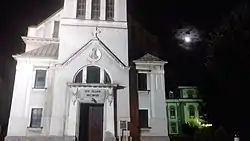

By the end of the 19th and at the beginning of the 20th century, urbanization was underway and the number of citizens increased several fold, according to the 1910 census in this place there were 7,215 men and women. The rapid growth was reflected by a construction boom: Orthodox Church of the Nativity of Our Lady in 1885, two Catholic churches in 1910, a synagogue in 1903 and the buildings of several lodgings for the night, hotels, schools, water supply, modern roads, etc.[10][8]
After World War I, the Kingdom of SHS was formed, which in 1929 became the Kingdom of Yugoslavia; Bosnia and Herzegovina belonged to these countries. The political, economic and social life of Bosnia and Herzegovina from 1918 to 1941 stagnated, although the situation changed slightly before the beginning of World War II, when certain investments in Ironworks Zenica came.[8]
20th century in Zenica is generally marked with series of different characteristic phenomena, increased industrialization, especially after 1938 with Harsh railway (Gruba pruga) being built, the pauperization of the part of the citizenry, its proletarization, as well as mixing of advanced urban European and still domestic Bosnian mentality and habits.[10][8]
Specific-functions-and-purposes city develops, especially bordered with two facts – Penitentiary and Ironworks Zenica – but also precious confirmation of the coexistence of the Zenicans with different histories; the stone bridge has connected house of Kosta Jefić and Osmanaga Mehmedić, and Jewish Havra, for over 90 years.[10][8]
Yugoslavia
In the period between 1941 and 1945, domestic people (mostly Muslims, by declaration of the famous Resolution of Zenica Muslims from May 1942)[22][23] show evident effort to retain respect and consideration as well as protection of bare life from non-Muslims,[22] through formation of their authentic sign, Muslim militias – in Šerići, Doglodi, Babino –, and through partisan units, what gave and had certain demands and weight.[24][8]
It was a dimension of Zenica way to have anti-fascist resistance; this city had no major destruction, terror and victims. The dimension of the anti-fascist struggle were determined by their nationalist) ideology – which surfaced during the war and declined after the war.[25][26][27][8]
After liberation of Zenica achieved by partisans on 12 April 1945 (Zenica Liberation Day),[26] the city started to grow rapidly – as a quickly developed industrial center. It expanded and included the former villages of Bilino Polje, Klopče and Radakovo; new flat blocks were built for more numerous coalminers and workers in the steelworks. Number of citizens in 1948 was only about 15,000, and by 1961 it grew up to over 30,000; in year 1981, there was over 63,000 citizens in Zenica, and after the last Yugoslavian census made in Yugoslavia – Zenica was city with over 96,000 citizens. For the time of the Yugoslavian period, which has lasted for about 50 years, the population increased sixfold.[28]
Bosnian War
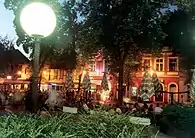
One year before the outbreak of the Bosnian War, in 1991, Zenica became the seat of one of the first private and independent radio stations in Eastern Europe – Radio CD-CEMP.[29] In the spring of 1993, journalist and owner of the Radio CD-CEMP, won a Belgian accolade for independent journalism – "The Pen Of Peace".[30]
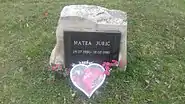
The first official civilian victim of the Bosnian War in Zenica was a two-year-old Croat girl Matea Jurić (29 July 1990 – 13 May 1992), who was killed by a gunshot during the blockade of the military barrack of JNA in the urban settlement of Bilimišće. Today, meeting to remember Jurić is traditionally organized in Radakovo, where she has a memorial panel next to which flowers are lain.[31]
On 19 April 1993, during the Croat–Bosniak War, 16 civilians were killed and 50, injured, when a HVO howitzer-fired grenade hit the central bazaar of Zenica.[32] The grenade was shot from the village of Putićevo [15 km (9.3 mi)]. A total of six grenades hit the target, three series of two.[33] During this period Zenica was isolated from the rest of the world for a year and a half. The city suffered significant loss of the civic society from sniper fire, arson and hunger. The fourth-biggest city of BiH had neither water nor electricity.[34]
During the war, an economic meeting ZEPS was still organized.[7]
Zenica's populace changed much during the war, with the arrival of Muslims (today's Bosniaks) from other parts of BiH and the departure of Serbs to areas under Serb control.[35]
- Historical images of Zenica
.jpg.webp) Bosanska Vila article (1890) on Fatih Mehmed's conquest of Gradišće and Vranduk in 1463
Bosanska Vila article (1890) on Fatih Mehmed's conquest of Gradišće and Vranduk in 1463 Vranduk Fortress panorama (1895)
Vranduk Fortress panorama (1895)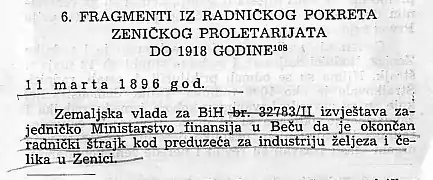 Zenica workers strike (1896), one (aside from 1898) before Chicago's in 1905
Zenica workers strike (1896), one (aside from 1898) before Chicago's in 1905%252C_%D0%A0%D0%B8%D1%85%D0%B0%D1%80%D0%B4_%D0%9A%D0%BE%D0%BD%D1%80%D0%B0%D0%B4_%D0%9A%D1%80%D0%BE%D0%BC%D0%B0%D1%80_%D1%84%D0%BE%D0%BD_%D0%A5%D0%BE%D1%85%D0%B5%D0%BD%D0%B2%D0%BE%D0%BB%D1%84.jpg.webp) Dorfleben (Village Life; 1903), watercolor by Richard Conrad Kromar (1874–1948)
Dorfleben (Village Life; 1903), watercolor by Richard Conrad Kromar (1874–1948)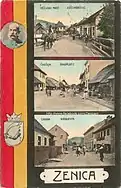 Tripartite postcard (1907)
Tripartite postcard (1907) Čaršija of Kočeva street (postcard; 1909)
Čaršija of Kočeva street (postcard; 1909)%252C_%D1%80%D0%B5%D1%82%D1%83%D1%88%D0%B8%D1%80%D0%B0%D0%BD%D0%B0_%D1%80%D0%B0%D0%B7%D0%B3%D0%BB%D0%B5%D0%B4%D0%BD%D0%B8%D1%86%D0%B0.jpg.webp)
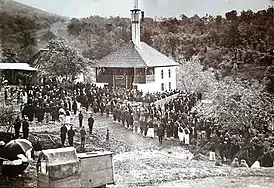 Ričice mosque inauguration (1928)
Ričice mosque inauguration (1928)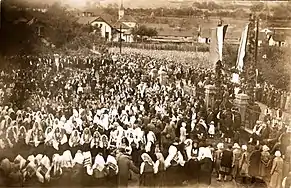 People's gathering in front of Catholic Church of St. Elijah on a holy day (1932)
People's gathering in front of Catholic Church of St. Elijah on a holy day (1932) Southern Zenica, downtown near Bosna (1935)
Southern Zenica, downtown near Bosna (1935)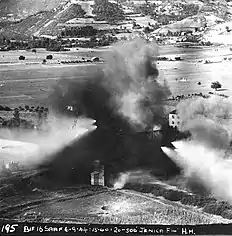 Bombing of the "Pehare" railway bridge by 16 Squadron SAAF (1944)
Bombing of the "Pehare" railway bridge by 16 Squadron SAAF (1944)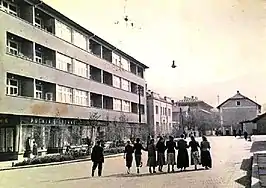 Zenican girls occupied Sarajevska street (1958)
Zenican girls occupied Sarajevska street (1958) Panoramic view of the Ironworks (postcard; 1964)
Panoramic view of the Ironworks (postcard; 1964)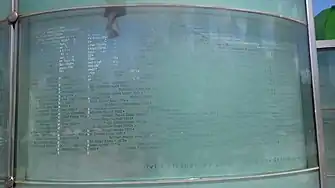 Part of the "Kameni spavač [Stone Sleeper] – Mak Dizdar" monument's vitreous memorial with names of thousands of Zenicans, victims of the Bosnian War (2019)
Part of the "Kameni spavač [Stone Sleeper] – Mak Dizdar" monument's vitreous memorial with names of thousands of Zenicans, victims of the Bosnian War (2019)
21st century
Zenica recovers from the war and continues to slowly progress. The ruling party in the City of Zenica for 20 years was the majority Bosniak and Muslim Party of Democratic Action (SDA), for which i.e. time of its mayors the development of the settled place Zenica / city of Zenica (its urban core but also other villages as the part of then Municipality) advanced slowly, partly because of corruption and various types of misappropriation;[36][37][38] many areas of the populated place itself did not get city lights, water supply and canalization and solidly asphalted roads even after 20 years.[39]
The drastic population decrease was seen from 1991 to 2013 and it is ≈26% (Zenica lost one quarter of its citizens, partly because of the War, partly because of unfavorable economic circumstances in BiH and recessions prompting young and middle-aged residents to emigrate to Europe and America).[28][5]
In 2014, Zenica – as well as other FBiH cities – saw violent citizen protests. The Municipality Building was smashed, RMK buildings also demolished, tens of people taken to the cantonal hospital and some officials resigned.[40]
Municipality of Zenica was recategorised on 20 November 2014 as the City of Zenica.[41]
2016 Bosnian-Herzegovinian municipal elections made independent politician (Fuad Kasumović) a Zenica mayor for the first time in the recent city history.[42] During the three years of his term he accelerated development, focused on the city's core i.e. settled place Zenica;[43] for the locations of priority importance, the city introduced city lights and water supply with canalization, road asphalting and transport improvement (bicycle lanes and stands for bicycles were introduced for the first time in Zenica's history on a mass scale, and since October 2019[44] also nextbike system[45] which 200 cities in the world have, but in BiH only Sarajevo, Banja Luka and Zenica have), plans for introducing a new heating system for the city are being made (Zenicans regularly face total turnoff or weak output of heating during the season, especially when it is coldest),[46] New Year's concerts began to be held on the main city square open for all citizens and visitors (the first one was in 2017/18 with Miligram making the show;[47] the second was in 2018/19 with Crvena jabuka) as the main act,[48] various new manifestations are organized for citizens and tourists (e.g. Zenica summer fest, music festival with domestic and regional stars that lasts for several weeks and takes place on the city square – the first was opened by Frenkie in the summer of 2018 and closed by Dubioza Kolektiv,[49] and Saša Kovačević opened the second in summer of 2019 and Željko Joksimović closed it;[50] artistic, trade and other bazaars and the like)[51][52][53][54][55] while the trade-economic fair with a long history ZEPS expands – thus improving tourist i.e. economic potential. These are all reasons because of which city has more visitors from all continents, of which it is significant to mention Africa and Asia. The issue of stray dogs in the urban core was handled,[56] pollution that culminated at the beginning[57] and in the mid-2010s was reduced significantly (Zenicans were used to a pink-red sky and stinky, polluted air especially during the nights of pollution),[58] public transport was improved (new buses, wi-fi etc.)... There are plans to resolve a huge problem of unemployment and to modernize the education system, build city underground garage,[59] as well as projects of warming the public city flat buildings with styrofoam facades.[60] Manifestation Čimburijada (Bosnian: čimbur – the local name for the scrambled eggs dish çılbır), that have been present for several decades in Zenica, took place in 2019, too, with video-broadcast on TV Zenica.[61]
Geography
Zenica is located in the heart of the Bosnia, in the central part of the river Bosna's flow, after which BiH is named. Coordinates of the city are 44° 12′ 14″ N and 17° 54′ 28″ E. Its average elevation is 310–350 m (1,017–1,148 ft) above sea level.
The area of Zenica is 43.01 km2 (16.61 sq mi), and the area of the City is 558.5 km2 (215.6 sq mi).
Location
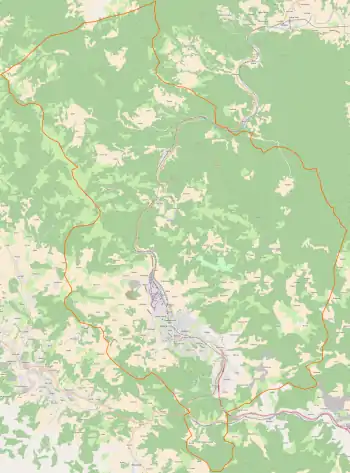
Relief and spread
Relief of the City of Zenica is valley-basin. It is made up of a series of alluvial planes, hills, mountain passes and the like. The average altitude of the city itself surrounded by hills is 310–350 m (1,017–1,148 ft); however, there are many higher positions, such as Tvrtkovac, a hikers' destination of Zenicans, whose altitude is 1,304 m (4,278 ft). The Zenica basin extends from the canyon Lašva river in the south to the Vranduk canyon and Vranduk gorge in the north – of an average length of 35 km (22 mi) and with an average altitude of 700 m (2,300 ft).[62][9] Overview of the highest hills and mountains is given in the table below.[9]
| Mountains and hills | Elev. [m (ft)] |
|---|---|
| Tvrtkovac | 1,304 (4,278) |
| Hum | 1,280 (4,200) |
| Vepar | 1,083 (3,553) |
| Lisac | 1,080 (3,540) |
| Smetovi | 940 (3,080) |
| Klopačke stijene | 918 (3,012) |
| Golubak | 700 (2,300) |
| Vučijak | 639 (2,096) |
| Zmajevac | 638 (2,093) |
| Volovska glava | 585 (1,919) |
| Janjićki vrh | 561 (1,841) |
The lowest parts in the relief context are along the river Bosna. As one moves towards east and west, altitudes increase; thus, northwestern and northeastern areas of the city are the highest.[9]
Waters
Zenica city is characterized by many small rivers and streams; all of them completely belong to the Bosna river basin.
River Bosna is the most important water flow in the Zenica area. Spring of the river Bosna in Ilidža, near Sarajevo, and mouth in the river Sava near Bosanski Šamac; thus, the river has a natural flow from south to the north, what is usually uncommon but characteristic for larger number of rivers in BiH.[63] Out of a total of 274 km (170 mi), which is the total length of the river Bosna, 47.95 km (29.79 mi) flows throughout the cityity. Along the river Bosna there are roads and railway built; also, most of the citizens is concentrated along river Bosna.[9]
Except Bosna, in the city itself there are flows of the rivers Lašva, Babina and Kočeva, and farther are Bistričak, Orahovička, Nemilska, Gračanička, Starinska and Džulanova rivers. The most significant streams are Tetovski, Zvečajski, Janjićki, Svitački and streams of Perin han I, Perin han II, Bukovica etc.[9]
Climate
| Zenica | ||||||||||||||||||||||||||||||||||||||||||||||||||||||||||||
|---|---|---|---|---|---|---|---|---|---|---|---|---|---|---|---|---|---|---|---|---|---|---|---|---|---|---|---|---|---|---|---|---|---|---|---|---|---|---|---|---|---|---|---|---|---|---|---|---|---|---|---|---|---|---|---|---|---|---|---|---|
| Climate chart (explanation) | ||||||||||||||||||||||||||||||||||||||||||||||||||||||||||||
| ||||||||||||||||||||||||||||||||||||||||||||||||||||||||||||
| ||||||||||||||||||||||||||||||||||||||||||||||||||||||||||||
In the Zenica City area, moderate continental climate prevails. Summers are hot and winters moderately cold. Mean annual temperature is 10.4 °C (50.7 °F), average annual precipitation 804 mm (31.7 in) and unevenly distributed during the year, provided that there are no exceptionally dry months (the lowest monthly precipitation is in March and the highest in November). The coldest month is January [average year minimum −1 °C (30 °F)] while July is the hottest [average year maximum 20.2 °C (68.4 °F)]. The lowest mean monthly temperature in Zenica was in January 1964 [−6.4 °C (20.5 °F); minimal −23.9 °C (−11.0 °F) in January 1963] and maximal mean monthly temperatures were registered in August 2003 [23.8 °C (74.8 °F); maximal 40.8 °C (105.4 °F) in August 2003]. Relative air humidity is 70% and cloudiness 6.1 tenths. Air pressure is 976.3 millibars. Zenica has one meteorological station; it was founded in 1925 and is located at an elevation of 344 m (1,129 ft) a.s.l.[9][64]
| Climate data for Zenica | |||||||||||||
|---|---|---|---|---|---|---|---|---|---|---|---|---|---|
| Month | Jan | Feb | Mar | Apr | May | Jun | Jul | Aug | Sep | Oct | Nov | Dec | Year |
| Average high °C (°F) | 3.8 (38.8) |
6.9 (44.4) |
12.1 (53.8) |
16.7 (62.1) |
21.5 (70.7) |
25.2 (77.4) |
27.8 (82.0) |
27.6 (81.7) |
23.7 (74.7) |
17.3 (63.1) |
10.0 (50.0) |
5.1 (41.2) |
16.5 (61.7) |
| Daily mean °C (°F) | 0.4 (32.7) |
2.6 (36.7) |
7.0 (44.6) |
11.2 (52.2) |
15.6 (60.1) |
19.2 (66.6) |
21.1 (70.0) |
20.7 (69.3) |
17.1 (62.8) |
12.0 (53.6) |
6.3 (43.3) |
2.1 (35.8) |
11.3 (52.3) |
| Average low °C (°F) | −3.0 (26.6) |
−1.7 (28.9) |
1.9 (35.4) |
5.8 (42.4) |
9.8 (49.6) |
13.2 (55.8) |
14.5 (58.1) |
13.9 (57.0) |
10.6 (51.1) |
6.7 (44.1) |
2.7 (36.9) |
−0.9 (30.4) |
6.1 (43.0) |
| Average precipitation mm (inches) | 70 (2.8) |
70 (2.8) |
64 (2.5) |
76 (3.0) |
85 (3.3) |
88 (3.5) |
72 (2.8) |
70 (2.8) |
72 (2.8) |
84 (3.3) |
105 (4.1) |
96 (3.8) |
952 (37.5) |
| Mean daily sunshine hours | 9.5 | 10.5 | 12 | 13.5 | 14.5 | 15.5 | 15 | 14 | 12.5 | 11 | 9.5 | 9 | 12.2 |
| Source: climate-data.org; for sun hours: NOAA | |||||||||||||
Ecology
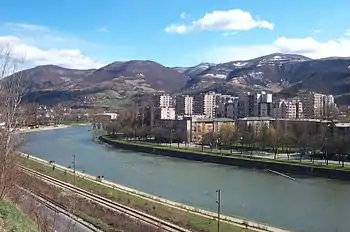
in the front: a railway, behind it the settlement of Jalija (right) and farther Bilimišće (left); in the back: Zenica hills – Krč rocks (right) and other (left)
Zenica's industry polluted and damaged the environment. After the Bosnian War, the main culprit for hard ecological state in Zenica, ironworks (today mostly converted into Arcelor Mittal, owned by Lakshmi Mittal), was incapacitated. However, a few years ago, the old steelworks partially resumed its operations, so because of these and other reasons the non-partisan, citizen organisation "Eko pokret Zenica" was founded in Zenica, and later the Greens of Bosnia and Herzegovina political party as well – with their seat in Zenica. In the city there is also "Eko-forum Zenica" as an acting organization.[65][66][67]
The Babina river basin was declared a nature park after their intercession. There are initiatives to create a dam on the Vranduk, what would cause ecological catastrophe. The Greens of Bosnia and Herzegovina, and "Eko pokret" as well, are against this and advocate declaring Vranduk a national park.[65]
The regional depony [waste landfill] "Mošćanica" (RDM) d.o.o. Zenica is located between Mošćanica, Mutnica, Palinovići, Briznik, Arnauti, Ponihovo and Plavčići villages, southeast of Zenica city;[68] it collects all waste from Zenica and its vicinity; the Zenica waste management company – which moves garbage to "Mošćanica" and curates city parks, streets, etc. – is the German company Alba d.o.o.[69][70]
Urban settlements
The urban part of Zenica consists of the following settlements – urban entireties:
- Jalija
- Odmut
- Mokušnice
- Londža
- Pišće
- Blatuša
- Crkvice
- Babina River [Babina Rijeka] (Old Radakovo)
- New Radakovo [Novo Radakovo]
- Sejmen
- Old Čaršija [Stara Čaršija] (toward Čaršijska mosque)
- New Zenica [Nova Zenica]
- Lukovo Field [Lukovo Polje]
Demographics
Zenica's population increased from 7,215 citizens in 1910 to 15,550 in 1948 and 63,869 in 1981.[28]
According to the Population census in SR BiH from 1991, Zenica had 96,027 citizens. Zenica Municipality had 145,517 citizens by same census data, in 81 settlements. According to the official data of the 2013 population census in Bosnia and Herzegovina for the Federation of Bosnia and Herzegovina published by the Federal Office of Statistics of the Federation of Bosnia and Herzegovina and then re-published by the Federal Office of Statistics, the populated place Zenica (without Upper Zenica and surrounding villages and places) had 70,553 residents, while the City of Zenica had 110,663 inhabitants.[5]
Many Serbs after the Bosnian War fled from the Zenica (either voluntarily or not);[71] now they live in Republika Srpska and elsewhere in the world, too; on the Federation of BiH level, they are reduced to a statistical error.[35]
Population of the settled place / city
| Ethnic composition[28][5] | |||||||||||||
| Year | Serbs | % | Bosniaks | % | Croats | % | Yugoslavs | % | Others | % | Total | ||
|---|---|---|---|---|---|---|---|---|---|---|---|---|---|
| 1961 | 10,525 | 32.41% | 5,908 | 18.19% | 9,393 | 28.92% | 5,517 | 15.31% | - | -% | 32,476 | ||
| 1971 | 12,779 | 24.93% | 21,365 | 41.68% | 13,250 | 25.85% | 1,945 | 3.79% | - | -% | 51,263 | ||
| 1981 | 12,728 | 20.02% | 22,146 | 34.84% | 11,716 | 18.43% | 14,437 | 22.71% | - | -% | 63,569 | ||
| 1991 | 18,312 | 19.07% | 43,154 | 44.94% | 15,809 | 16.46% | 14,703 | 15.31% | 4,049 | 4.22% | 96,027 | ||
| 2013 | 2,296 | 3.25% | 55,239 | 78.29% | 6,746 | 9.56% | - | -% | 6,272 | 8.89% | 70,553 | ||
Population of the municipality / City
| Ethnic composition[28][74] | |||||||||||||
| Year | Serbs | % | Bosniaks | % | Croats | % | Yugoslavs | % | Others | % | Total | ||
|---|---|---|---|---|---|---|---|---|---|---|---|---|---|
| 1961 | 20,369 | 24.15% | 31,177 | 36.97% | 20,509 | 24.32% | 10,755 | 12.75% | - | -% | 84,341 | ||
| 1971 | 21,875 | 19.45% | 61,204 | 54.43% | 24,658 | 21.93% | 2,133 | 1.90% | 2,577 | 2.29% | 112,447 | ||
| 1981 | 21,204 | 15.97% | 66,930 | 50.42% | 23,595 | 17.78% | 17,536 | 13.21% | - | -% | 132,733 | ||
| 1991 | 22,592 | 15.52% | 80,377 | 55.21% | 22,651 | 15.56% | 15,651 | 10.75% | 4,306 | 2.96% | 145,577 | ||
| 2013 | 2,409 | 2.17% | 92,988 | 84.02% | 8,279 | 7.48% | - | -% | 6,987 | 6.31% | 110,663 | ||
Common surnames
The most common surname in Zenica is Delić (983 persons).[75] It is followed by Spahić (878),[75] and the most common BiH surname[76] – Hodžić[76] (815).[75] These are followed by Bajramović (701), Isaković (688), Imamović (669), Halilović (649), Beganović (643) and Šišić (566).[75] The previously mentioned surnames are borne by about 5.5% of the city's population.[75] Other common surnames are Arnaut, Babić, Bašić, Durmić, Fejzić, Pašalić, Mahmić, Kovačević and Alić.[75]
In Zenica-Doboj Canton, as of February 2020, most common surnames are (descending incidence, all with incidence >1,000 are listed):[77]
- Hodžić
- Halilović
- Delić
- Spahić
- Bašić
- Imamović
- Kovačević
- Kadrić
- Tadić
- Marković
- Babić
- Begić
- Alić
- Šehić
- Selimović
- Beganović
- Hadžić
- Muratović
- Tomić
- Šišić
- Dedić
- Karić
- Smajić
- Sinanović
- Jukić
- Vidović
- Ramić
- Dizdarević
- Brkić
- Softić
- Avdić
- Pavlović
- Matijević
- Bošnjak
- Pašalić
- Šabanović
- Fejzić
- Radić
- Kovač
- Lukić
- Petrović
- Hasić
Economy
.jpg.webp)
Zenica is a famous industrial center.[78] In the development politics until today, base branches of industry prevailed (production of iron and steel, and coalmining). Exploitation of brown coal in Zenica has begun in 1880, and production of steel in 1892.[79]
In the pre-war period (in 1990), Zenica produced, among others, 1.4 tons of steel and 924,000 tons of coal, 1,018,000 m2 (10,960,000 sq ft) of cloth, 158,000 hL of milk etc. Employed workers numbered 53,419 – 49,415 in the social sector (42,965 economy and 6,450 non-economy), and 4,004 employed men and women in private sector.[79]
Even though the Bosnian War (1992–1995) did not bring destruction into Zenica to the extent it did elsewhere, the war damaged the economy. It is reflected in the interruption of the continuous process of steel production and a huge decrease in its production.[79]
Farming and cattle breeding have significant preconditions for further increase in production, with greater application of agrotechnical measures. In the farming production, the most prominent is the production of high quality potatoes – with significant market surpluses, carrots, onion, maize, wheat and vegetables. Outside Zenica, the famous sheep cheese is praised and sought after.[79]
- Metal-sector companies
The most notable metal-sector companies from Zenica are ArcelorMittal, Femetall, Cimos, RM-LH, Bosio, Treasure.
Politics
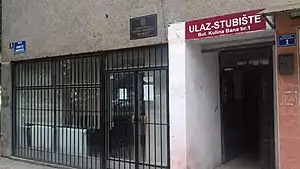
Official symbols
The City of Zenica (City) has a coat of arms and a flag, which are official for the populated place (city), too.[80][81][82][83]
CoA
The coat of arms is a square vertical rectangular field with half-circularly rounded bottom part framed with two lines, that have equal thickness and interspace. It has six elements shown with black lines of the same thickness. On the left side, following the frame of the coat of arms' field, the contour of the Bosna river can be seen, cut by two horizontal lines in the lower part – symbol of communication. In the remaining part of the coat of arms, there are four circular symbols (clockwise): the symbol of Vranduk – northern gate of the city; one of the six crosses from ban Kulin's plate, symbol of Christianity at the same time; crescent moon – symbol of Islam and Ottoman period; and crossed hammers – symbol of coalmining and heavy industry and indirectly symbol of Austro-Hungarian period, too. The field of the coat of arms is colored yellow and light green. Yellow covers the field until the upper two circle elements level and the rest of the field is green. The crescent moon in the lower part is yellow in the variant. The contour of the river is almost white.[80][81][82][83]
Flag
Zenica's flag's background is of same yellow and light green color as CoA has[80][81] (there is also a variant with background of white color).[84] Width vs length relationship is 1:2 (for white 3:7).[84][80][81][82][83] Flag needs not to be used vertically positioned in all its variants.[80][81] At the middle part there is uncolored coat of arms (only contours);[80][81][82][83] in the white variant CoA is colored.[84] The width of the coat of arms occupies around 1⁄3 of the horizontal i.e. 2⁄3 of the width of the vertical flag,[80][81][82][83] and in the variant with white background[84] the height of the coat of arms occupies 3⁄7 of the vertical flag height.[84][80][81][82][83]
- Usage
Conditions and the way of usage of the coat of arms of Zenica is regulated by a special decision of the Council (see admin structure right below).[80][82][83]
Governance: The seat of administration of the City
In the populated place Zenica there is seat of the Authority of the City of Zenica and seat of City of Zenica (Municipality until 2014); the Authority consists of a City Mayor (Municipality Mayor until 2014), the Council of the City of Zenica (Municipality Council until 2014) and City Attorney's Office (Municipality Attorney's Office until 2014).[85]
Mayors and City Mayors
24th mayor (1970–1974)
36th mayor (2016–today)
For Zenica city role of importance is consequently mandated by City Mayor of Zenica City. Below is a list of former Zenica Mayors1–36 + * and City Mayors**.
- Suljo Arnaut (1878)
- Ahmetaga Mutapčić (1889–1895)
- Esad Alikadić (1898–1905)
- Ali Harmandić (1906–1913)
- Mahmud Tarabar (1913–1917)
- Osman Mutapčić (1917–1923)
- Ivo Ghey (1923–1925)
- Ahmed Mutapčić (1926–1931)
- Abdulaziz Asko Borić (1932–1935)
- Eniz Mutapčić (1935–1936)
- Mehmedalija Tarabar (1936–1941)
- Ismet Salčinović (1941–1946)
- Mustafa Čolaković (1945)
- Mustafa Mujagić (1945)
- /9./ Abdulaziz Asko Borić (1945–1946)
- Jozo Marčinković (1946–1948)
- Veljko Bilanović (1949–1950)
- Nikola Spaić (1951–1952)
- Safet Uzunović (1952–1955)
- Đuro Vekić (1955–1959)
- Milko Križanović (1959–1960)
- Ezher Ezo Arnautović (1960–1965)
- Vinko Jelčić (1965–1966)
- Muhamed Berberović (1966–1970)
- Abdulah Mutapčić (1970–1974)
- /23./ Vinko Jelčić (1974–1978)
- Nikola Mirković (1978–1982)
- Salim Tarabar (1982–1983)
- Muhamed Pašalić (1983–1984)
- Nikola Telebak (1984–1985)
- Omer Filipović (1986–1988)
- Bogdan Kolar (1988–1990)
- Ibrahim Alispahić (1990–1992)
- Besim Spahić (1992–1997)
- Ferid Alić (1997–2000)
- Zakir Pašalić (2000–2004)
- [mands. 37, 38 & 39] Husejin Smajlović (2004–2016)*, **
- [mands. 40 & 41] Fuad Kasumović (2016–today)**
- source: [86]
Non-governmental organizations
Scouts (Izviđači) are a children's and youth movement, and they accomplish their goals and programs with help of adult members of the organization.
Scouts mainly acquaint nature, make friendships (children socialization) and learn useful skills that can help in the future of the life – both in the civilized world and nature. The scout organization in Zenica marked in 2017 its 65th anniversary of continuous existence. Since its founding there have been about 100,000 young people with different orientations in the Zenica scout organization.[87][88]
Culture
The city has the following institutions of cultural importance: the Camera Symphony Orchestra; Bosnian People's Theater with the Great Scene, Small Scene, Scene in the Basement and Kabare; Youth chorus; Art gallery; Museum of the City of Zenica. At the Bosnian People's Theater, beside the permanent ensemble, the Children's scene is also active with its own program.
The Croat culture society "Napredak" (Advancement), Zenica affiliate, from 2010 has organized within Easter days every year "Tucijada" (beating eggs), competition on the occasion of the biggest Catholic festivity Easter. The goal is to find a participant with the strongest Easter-egg shell. Manifestation takes place in the rooms of the Croat house.[89] Since 2010 CCS "Napredak", Zenica affiliate, organizes every year on the occasion of Easter days Festival of the natural rakijas and liqueurs, also in the Croat house.[90][91]
The medieval musical ensemble Fugato is from Zenica, and so are the reggae/dub/rock band Dubioza Kolektiv and pop-rock band Nemoguće Vruće. GUD "Filigran" Zenica and tamburaši "Zlatna žica" on 30 July took part in the International tamburaši's meetings (Međunarodni tamburaški susreti), that represented the eight-night show of Zenica summer fest 2019 (19 July – 9 August).[92]
National monuments

There are several national monuments of Bosnia and Herzegovina in Zenica, at the former Municipality's i.e. City from 2014. On the list of national monuments of BiH for Zenica there are following monuments:
- Church of the Nativity of Our Lady (historic building),
- St. Elijah Church with parish office (building entirety),
- Building entirety of former Paper factory (Papirna)
- Plate of the great judge Gradeša, property of the Museum of the City of Zenica (moving well),
- Sejmenska mosque (Zenica), place and the remains of building entirety,
- Old mosque with harem in Orahovica (building entirety),
- Old city of Vranduk (building entirety),
- Sultan Ahmedova mosque and Madrasah (building entirety),
- The building of the former Synagogue in Zenica (historic monument).[93]
Attractions
- Tvrđava Vranduk [Vranduk fortress]
- Zenička sinagoga [Zenica synagogue]
- Spomenik Kameni spavač [Stone sleeper monument]
- Spomenici NOB-a [NOB monuments]
- Bulevar Kulina bana [Kulin ban's boulevard]
- Stara čaršija [Old Čaršija]
- Hadži Mazića kuća [Hadži Mazića house]
- Medresa [Madrasah]
- Korzo [Corso]
- Kameniti most [Stone bridge]
- Muzej grada Zenice [Zenica City Museum]
- Crkva Rođenja Svete Bogorodice [Church of the Nativity of Our Lady]
- Crkva Svetog Ilije [St. Elijah Church]
- Čaršijska džamija [Čaršijska mosque]
- Sejmenska džamija [Sejmenska mosque]
- Smetovi [Smetovi]
- Bistričak [Bistričak]
- Kamberovića polje [Kamberovića polje]
- Lamela [Lamela]
- Bosansko narodno pozorište [Bosnian People's Theater]
- Gradska tržnica [City tržnica]
- Sajam ZEPS [ZEPS fair]
- Sajam Dani organske proizvodnje [Days of organic production fair]
- Festival Zenica summer fest [Zenica summer fest festival]
- Robne kuće Bosanka and Zeničanka [Bosanka & Zeničanka shopping malls]
- Šoping-centar Džananović [Shopping center Džananović]
- MI "Kemal Kapetanović" [MI "Kemal Kapetanović"]
- Željezara Zenica [Ironworks Zenica]
- Papirna [Papirna]
- Rudnik Stara jama [Old pit mine]
- Zenički zatvor [Zenica prison]
- Dom Armije, bivši Dom JNA [Army house, former JNA house]
- Zenička arena [Zenica arena]
- Hotel Internacional [International hotel]
- FK Čelik [FC Čelik]
- Stadion Bilino polje [Bilino polje stadium]
- Četiri solitera na Odmutu [Four soldiers on Odmut]
- Zgrada Jabuka [Apple building]
- Crkvice [Crkvice]
- Jalija [Jalija]
- Janjići [Janjići]
- Drivuša [Drivuša]
- Carina i Stari mlin u Zacarini [Carina and Old mill in Zacarina]
- Bazeni u Babinoj Rijeci [Pools in Babina Rijeka]
- Kino CineStar [CineStar Zenica (Ekran Family Center)]
- Zelena & Buvlja/stočna pijaca [Green & Flea/cattle piazzas]
- Gradska kafana [City kafana]
- Mljekara ZIM [Dairy factory ZIM]
- PZ Nova Zenica i Kanal [BZ New Zenica and Kanal]
- Most Drvena ćuprija [Wooden cuprii bridge]
- Viseći Jalijski most [Suspended Jalija bridge]
- Dom penzionera Zenica [Retirement home Zenica]
- Spomenik ZPO na Smetovima [Monument to ZPO on Smetovi]
- Zgrada HKD "Napredak" [Building of HCS "Napredak"]
Sports
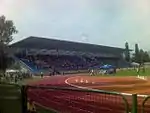
Zenica has a remarkable base for the development of sport and mass physical culture. Zenica sportspeople and sports workers achieved a series of noted results – both on Bosnia and Herzegovina and international sports scenes.[94]
FC Čelik is a two-time winner of the former Central European Cup.[95] From the recognition of Bosnia and Herzegovina, Čelik has thrice been state champion,[95] and won the Cup twice. Significant results were made also by rugby players of Čelik, who were eight-time champions of SFR Yugoslavia, won the Cup six times and were double champions of BiH.[94]
Since 1992, noted international results were made by tennis player Mervana Jugić, high jumper Elvir Krehmić, shooter Šejla Kurtagić, karatist Arnel Kalušić etc.[94]
Zenica has 45 working clubs in which there are many professional and amateur sportsworkers employed. Zenica is also the only BiH city in which there is working Club of extreme sports (Scorpio), that focuses on alpinism and sports climbing.[94]
Clubs list
- Aeroklub "Zenica" [aeroclub]
- Asocijacija radio-amatera [radio-amaeteurs]
- Asocijacija radio-amatera radio-klub "Zenica" [radio-amaeteurs]
- Atletski klub "Zenica" [athletics]
- Biciklistički klub "Zenica – Metalno" [byciclism]
- Bokserski klub "Čelik" [box]
- Invalidski odbojkaški klub "Bosna" [disabled volleyball]
- Džudo klub "Policajac" [Judo]
- Karate klub "Hasen-do" [Karate]
- Karate klub "Zenica – Mladost" [Karate]
- Karate klub "Nico" [Karate]
- Košarkaški invalidski klub "Bosna" [disabled basketball]
- Klub borilačkih vještina "Isak" [martial arts]
- Klub ekstremnih sportova "Scorpio" [extreme sports]
- Košarkaški klub "Čelik" (žene) [basketball (women)]
- Košarkaški klub "Čelik" [basketball]
- Košarkaški klub "Željezara – Zenica" (žene) [basketball (women)]
- Klub sjedeće odbojke "Zenica 92" [sitting volleyball]
- Malonogomentni klub "Drugari" [futsal]
- Fudbalski klub "Borac" (Tetovo) [football]
- Fudbalski klub "Iris" (žene) [football (women)]
- Fudbalski klub "Čelik" [football]
- Fudbalski klub "Nemila" [football]
- Fudbalski klub "Zenica 97" [football]
- Fudbalski klub "Zlatni ljiljan" [football]
- Fudbalski klub "Željezničar" [football]
- Odbojkaški klub "Zenica" [volleyball]
- Odbojkaški klub "Ruki" [volleyball]
- Plivački klub "Željezara" [swimming]
- Plesni klub "Latino" [dance]
- Rafting klub "Žara" [rafting]
- Rafting klub "Bosna" [rafting]
- Ragbi klub "Čelik" [rugby]
- Ragbi klub "Rudar" [rugby]
- Ragbi klub "Zenica 72" [rugby]
- Rukometni klub "Čelik" [handball]
- Smučarski klub "Zenica" [skiing]
- Stonoteniski klub "Mladost" [table tennis]
- Stonoteniski klub "Željezara" [table tennis]
- Streljački klub "Zenica" [shooting]
- Šahovski klub "Čelik" [chess]
- Šahovski klub "Preporod" [chess]
- Teniski klub "Čelik" [tennis]
- Tekvondo klub "Zenica" [Taekwondo]
- Udruženje građana sportskih ribolovaca RD "Bistro" Zenica [fishing]
- source: [94]
Transportation and infrastructure

Zenica is connected with Sarajevo [70 km (43 mi) South-East] by railway and road lines – both of which follow the valley of the Bosna river. Highway А1 connects Zenica with Sarajevo and Mostar. The railway follows further to the south, and at the end it comes to the coast in Ploče (Croatia).[78]
Roads in the city are relatively bad. Exceptions are the newly built main city magistral (GGM) and some parts of the main city roads in the center and New Zenica. Widening of the roads toward some surrounding settlements and villages is being prepared, and works have begun in some places already (roads around Vranduk, towards Nemila and Bistričak resort).[96]
The most important infrastructure and transportation companies from Zenica (all d.o.o.) are Almy Gradnja, ITC, Arcon, Arel, Uniprojekt Komerc – Inžinjering, Komgrad – Ze, Almy-transport, Geosonda, Engra, ŽGP – Zenica.
The closest airport is Sarajevo International Airport.[78]
- Rebuilding of Vranduk tunnel
During 2019, the city faces the problem of rebuilding the "Vranduk" tunnel, that will according to the plans last even until the end of the first quarter of the following year;[97] transportation was basically done in one lane alternately, and sometimes there was complete stopping of traffic and accidents of many types occurred very often (vehicles go off the narrower alternative roads, drivers engage in physical clashes due to impatience and heat, etc.).[98][99][100][101][102]
Education

There are 19 elementary and 12 high[103] schools in Zenica city. Among others, there are elementary[104] and high[105] music schools, an elementary special school,[106] and Catholic school center "Saint Paul" which has an elementary school and a gymnasium.[107]
Zenica is a university city.[78] The University of Zenica consists of several faculties: Mechanical Engineering Faculty, Metallurgy and Materials Faculty, Philosophy, Law, Economics, Medicine, Islamic Pedagogical Faculty and Polytechnic Faculty.[78]
Media
The main medium of communication in the city is its public service, Radio and Television of Zenica (RTVZE). It is seated in Boulevard of King Tvrtko I street, across the road where the main city bus station is located.[108] There are no other television stations in the city; the closest is NTV IC Kakanj. There are many other radio stations, such as: Radio Zenit, Narodni Radio Zenica, Radio Mix, Radio TNT Zenica, Radio ZOS, Uživo radio, BM radio (former), Q radio Zenica, YUB radio, Radio Zeničko nebo, and Radio Dijaspora Zenica.
Zenica has one newspaper and it is free of charge (also the first Bosnian free newspaper), Superinfo, distributed to the citizens at street stands (rarely, nowadays) or by paper boys who bring them to most of the public flat buildings in the city.[109] The city has an official gazette (Službene novine Grada Zenica).[110] The seats of the national Dnevni avaz and Oslobođenje and local Naša riječ newspapers correspondence offices are located in Zenica, in the "Jabuka" building below Hamida hill, in Masarykova and on the other side of the building where RTVZE has its seat, respectively.
Notable people
- Hasiba Agić, Sevdalinka folk singer and interpreter
- Bruno Akrapović, former football player
- Hamza Alić, shot putter – Balkan champion and European silver medalist
- Teoman Alibegović, basketball player
- Anabela Basalo, writer
- Sandra Bagarić, soprano and TV presenter
- Kenan Bajramović, basketball player
- Mensur Bajramović, basketball coach and BiH representation selector
- Elvir Bolić, former football player
- Senad Brkić, football player
- Ante Budimir, football player
- Aljoša Buha, musician, bassist, Crvena jabuka, Kongres
- Jasmin Burić, football player – goalkeeper
- Dragan Čavić, Serb politician, fifth president of Republic of Srpska (2002–2006)
- Jasmin Dizdar, film director
- Tarik Filipović, actor and TV presenter
- Nikolina Grabovac, basketball player (Croatia)
- Ahmet Hadžipašić, prime minister of FBiH Government (2003–2008)
- Adnan Harmandić, handball player
- Esad Hećimović, investigative journalist
- Arif Heralić, smelter from Ironworks Zenica, worker of Zenica – Metalno; his face is on the Yugoslavian note of 1,000 dinars (1955)
- Mirsad Hibić, former football player
- Mirjana Horvat, shooter
- Branimir Hrgota, football player (Sweden)
- Amar Jašarspahić Gile, pop-folk singer
- Darko Jelčić, musician, drummer, Crvena jabuka
- Mervana Jugić-Salkić, tennis player
- Edin Karamazov, a musician of international character, the master of lute[111]
- Dubioza Kolektiv, ska/reggae/rock/hip-hop band
- Elvir Krehmić, high jumper – BiH recorder
- Mladen Krstajić, football player, Partizan Belgrade (Serbia)
- Igor Laikert, Bosnian-Herzegovinian alpine skier
- Otto Lang, ski legend and American film producer
- Dejan Lovren, football player (Croatia)
- Danijel Ljuboja, theater actor, member of the ZKM ensemble (Croatia)
- Emir Mutapčić, former basketball player and basketball coach
- Ivan Opačak, basketball player
- Semir Osmanagić, archaeologist
- Srećko Pejović, shooter, world recorder
- Mesud Pezer, shot putter – bronze player on Mediterraneas plays 2018
- Vanja Plisnić, basketball player (Serbia)
- Senad Podojak, Koran reciter
- Emir Preldžić, basketball player
- Milorad Ratković, former football player – European cup winner
- Hasan Rizvić, basketball player (Slovenia)
- Nermin Šabić, football player
- Zoran Savić, former basketball player – Olympic silver medalist, world and European champion; general manager of Barcelona (Spain)
- Vuka Šeherović, folk singer
- Ivan Šunjić, Croatian football player
- Danis Tanović, film director, Oscar winner
- Amel Tuka, runner at 800 m – Balkan and Diamond league in Monaco champion
- Siniša Ubiparipović, former football player (USA)
- Nemoguće Vruće, rock band
- source: [112]
International relations
Zenica is twinned (as 'Partner Cities', by 'Twinning Charter') with:[113]
 Gelsenkirchen, Germany
Gelsenkirchen, Germany Hunedoara, Romania
Hunedoara, Romania Üsküdar (Istanbul), Turkey
Üsküdar (Istanbul), Turkey Karşıyaka (İzmir), Turkey
Karşıyaka (İzmir), Turkey Luleå, Sweden
Luleå, Sweden Zalaegerszeg, Hungary
Zalaegerszeg, Hungary Fiorenzuola d'Arda, Italy
Fiorenzuola d'Arda, Italy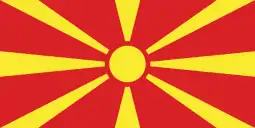 Veles, North Macedonia
Veles, North Macedonia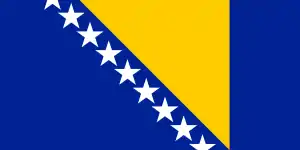 Jajce, Bosnia and Herzegovina
Jajce, Bosnia and Herzegovina
Gallery
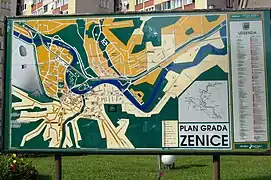 City plan map
City plan map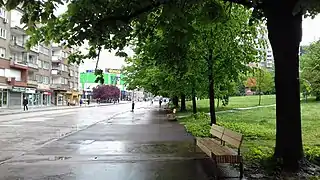 Čaršija, downtown area; Bosanka mall
Čaršija, downtown area; Bosanka mall Bosnian people's theatre
Bosnian people's theatre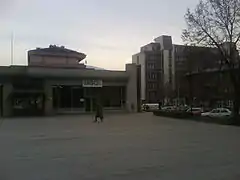 City kafana near theatre
City kafana near theatre Old municipality building
Old municipality building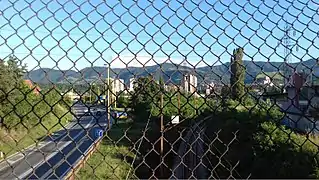 Fence view on the city from Pehare
Fence view on the city from Pehare.jpg.webp) Sahat-kula (clock tower) on Kamberovića polje
Sahat-kula (clock tower) on Kamberovića polje.jpg.webp) Boulevard of Kulin ban, near Bilino Stadium polje
Boulevard of Kulin ban, near Bilino Stadium polje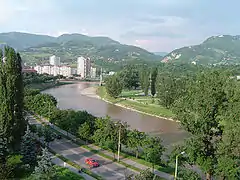 Boulevard and river Bosna
Boulevard and river Bosna Winter cityscape from Zmajevac
Winter cityscape from Zmajevac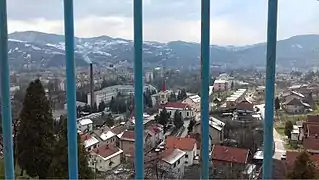 Winter cityscape view from the road to Smetovi, church and hospital in the foreground
Winter cityscape view from the road to Smetovi, church and hospital in the foreground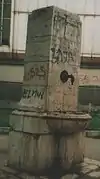 Konjska česma
Konjska česma Hadži Mazića kuća
Hadži Mazića kuća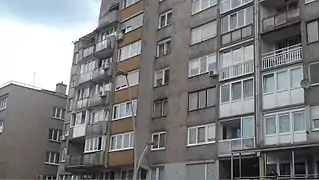 Common architecture, Londža
Common architecture, Londža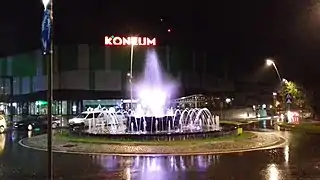 Fountain on Uglovnica
Fountain on Uglovnica GGM
GGM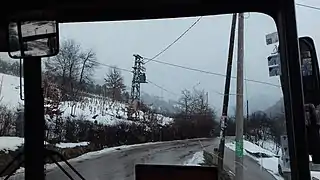 Bus and cemetery
Bus and cemetery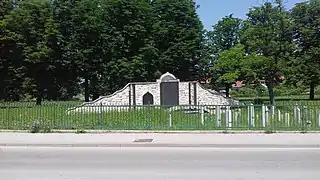 Memorial across City turbe
Memorial across City turbe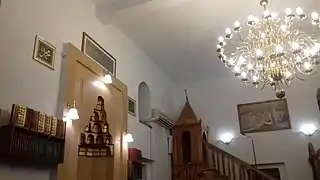 Sejmenska mosque interior at night
Sejmenska mosque interior at night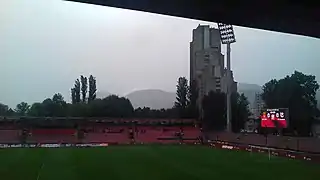 FC Čelik – FC Sarajevo match
FC Čelik – FC Sarajevo match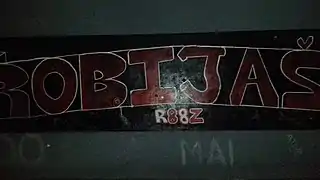 FC Čelik fan graffiti on Jalija
FC Čelik fan graffiti on Jalija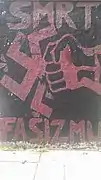 Death to fascism graffiti
Death to fascism graffiti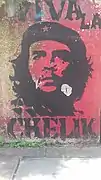
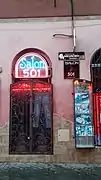 Vintage shop†
Vintage shop†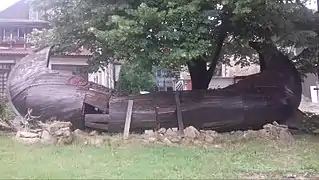 Wrecked monumental ship on Carina‡
Wrecked monumental ship on Carina‡_(14781201912).jpg.webp) Historical image
Historical image
See also
Notes
References
- "Akcioni plan energetski održivog razvoja Grada Zenica" (SEAP/ZEDA presentation). www.zeda.ba (in Bosnian). Archived (PDF) from the original on 11 August 2019.
Zenica kao ”zeleni čelični grad [Steel city]” gradi zdravu i bogatu budućnost...
- Iron city
- Nicaze 1
- Nicaze 2
- "Naselja 2013". www.statistika.ba (in Bosnian). Archived from the original on 20 July 2019. Retrieved 20 July 2019.
- "Župa Svetog Josipa – Zenica" (in Croatian). Retrieved 25 April 2019.
- "Historija Zenice". www.zenica.ba (in Bosnian). Archived from the original on 21 July 2019.
- "Historija Zenice" (official web-presentation of the City). gradzenica.weebly.com (in Bosnian). Archived from the original on 21 July 2019. Retrieved 21 July 2019.
- Sarajlić, Dženita. "Saobraćajne karakteristike grada Zenice" (seminar work). academia.edu (in Bosnian). Archived from the original on 21 July 2019. Retrieved 21 July 2019.
- "Grad Zenica: Ime grada prvi put se spominje 20. marta 1436. godine". akta.ba (in Bosnian). Archived from the original on 21 July 2019. Retrieved 21 July 2019.
- Glamočanin, Fidreta (12 April 1980). "Zenica : 35 godina u slobodi" [Zenica : 35 years in the freedom]. Naša riječ (in Serbo-Croatian): 4. Archived from the original on 7 December 2020. Retrieved 7 December 2020.CS1 maint: unfit URL (link)
- "Arheološki nalazi svjedoče da su naselja oko Zenice stara oko 3.100 godina" (original report). www.fena.ba (in Bosnian). FENA. 28–29 August 2019. Archived from the original on 29 August 2019. Retrieved 29 August 2019.
- "Arheološki nalazi svjedoče da su naselja oko Zenice stara oko 3.100 godina" (amplier report). tv1.ba (in Bosnian). Televizija Jedan d.o.o. 29 August 2019. Retrieved 29 August 2019.
- "Arheološki nalazi: Naselja oko Zenice stara oko 3.100 godina". www.nezavisne.com (in Serbian). NIGD "DNN" (Dnevne nezavisne novine). 29 August 2019. Archived from the original on 29 August 2019. Retrieved 29 August 2019.
- "Arheološki nalazi svjedoče da su naselja oko Zenice stara oko 3.100 godina". ba.n1info.com (in Bosnian). N1. 29 August 2019. Archived from the original on 29 August 2019. Retrieved 29 August 2019.
- "Zenica". LZMK (in Croatian).
- Vego, Marko (1957). Naselja bosanske srednjovjekovne države (in Croatian). Sarajevo: Svjetlost. p. 12.
- "Zenica: Najstarije džamije Sultan Ahmedova i Sejmenska". vijesti.ba (in Bosnian). Archived from the original on 20 July 2019. Retrieved 21 July 2019.
- "Jedna od najstarijih džamija u Zenici uskoro dobiva novo ruho". avaz.ba (in Bosnian). Archived from the original on 20 July 2019. Retrieved 21 July 2019.
- "Šetnja kroz džamije: Sejmenska džamija u Zenici". 072info.com (in Bosnian). Archived from the original on 20 July 2019. Retrieved 21 July 2019.
- "SEJMEN". mizzenica.ba (in Bosnian). Islamska zajednica u Bosni i Hercegovini – Medžlis Islamske zajednice ZENICA. Retrieved 26 July 2019.
- "Ulema u odbrani života i čovjeka". islamskazajednica.ba (in Bosnian). Archived from the original on 21 July 2019. Retrieved 21 July 2019.
- "Muslimanske rezolucije". preporodbn.com (in Bosnian). Archived from the original on 21 July 2019. Retrieved 21 July 2019.
- "ZENICA - Seoske milicije u samoodbrani" (famous FB page managed by old Zenican Mirsad Đulbić, admin who posts historical verified content followed by thousands of other Zenicans). ZENICA - Stare slike i pričice (in Bosnian). Facebook. Archived from the original on 21 July 2019. Retrieved 21 July 2019.
- Đidić, Fuad; Hećimović, Esad (1991). Robija šutnje : (stradanje Muslimana u zeničkom kraju) : 1945–1987 (in Bosnian). Zenica: Preporod. COBISS.BIH 2104867.
- "FOTO: Obilježen 12. april – Dan oslobođenja Zenice". zenicainfo.ba (in Bosnian). Archived from the original on 21 July 2019. Retrieved 21 July 2019.
- "Mala škola antifašizma u Zenici". oslobodjenje.ba (in Bosnian). Archived from the original on 21 July 2019. Retrieved 21 July 2019.
- Federal Bureau of Statistics and Records of FNRY and SFRY: Population census 1948 (p. 5), 1953 (p. 62), 1961 (p. 124, 125), 1971 (p. 110, 112), 1981 (p. 30) and 1991 (p. 2).
- "Super info, broj 23" (PDF). superinfo.ba (in Bosnian). Archived (PDF) from the original on 21 July 2019. Retrieved 21 July 2019.
- "Zoran Misetic: Director of Global Business Development". LinkedIn. Archived from the original on 26 May 2019. Retrieved 21 July 2019.
- "Sjećanje na Mateu Jurić, prvu civilnu žrtvu rata u Zenici". n1info.com (in Bosnian). Retrieved 22 July 2019.
- "Odata počast ubijenim civilima Zenice". www.zenica.ba (in Bosnian). Archived from the original on 21 July 2019. Retrieved 21 July 2019.
- "IV. ATTACKS ON TOWNS AND VILLAGES: KILLINGS: 9. The Shelling of Zenica". www.icty.org. Archived from the original on 21 July 2019. Retrieved 21 July 2019.
- "U ratu sam osjetio potrebu za Bogom" (feuilleton). e-novine.com (in Bosnian). Archived from the original on 21 July 2019. Retrieved 21 July 2019.
- "Srbi u Federaciji "statistička greška"!". Večernje novosti (in Serbian). 2 July 2016. Retrieved 17 May 2017.
- "NAKON ŠTO JE BIO POD ISTRAGOM: Glavna tužiteljica na promociji knjige funkcionera SDA". zurnal.info (in Bosnian). Archived from the original on 21 July 2019. Retrieved 21 July 2019.
- "Sporazum Sarajlića i Vrače klasična politička korupcija? Hoće li koalicija "zaštitara" i SDA završiti u tužilaštvu". usn.co.ba (in Bosnian). Archived from the original on 21 July 2019. Retrieved 21 July 2019.
- "BiH godišnje gubi i do milijardu KM: Javne nabavke jedan od najvećih izvora korupcije". www.bh-index.com (in Bosnian). Archived from the original on 21 July 2019. Retrieved 21 July 2019.
- "Završni radovi na asfaltiranju Lašvanske ulice". zenicainfo.ba (in Bosnian). Archived from the original on 21 July 2019. Retrieved 21 July 2019.
- "Epilog protesta širom BiH". www.dw.com (in Bosnian). Archived from the original on 21 July 2019. Retrieved 21 July 2019.
- "Zenica zvanično postala grad". n1info.com (in Bosnian). Archived from the original on 21 July 2019. Retrieved 21 July 2019.
- "Fuad Kasumović slavi u Zenici: Bio sam siguran u svoju pobjedu". www.klix.ba (in Bosnian). Archived from the original on 21 July 2019. Retrieved 21 July 2019.
- "FK, program". fuadkasumovic.ba (in Bosnian). Archived from the original on 31 October 2016. Retrieved 21 July 2019.
- "Nextbike i u Zenici: Na šest lokacija građanima na raspolaganju 30 bicikala". radiosarajevo.ba (in Bosnian). 11 October 2019. Archived from the original on 11 March 2020. Retrieved 11 March 2020.
- "nextbike Zenica". Retrieved 11 March 2020.
- "POVODOM PRVE GODINE MANDATA: Gradonačelnik Zenice Fuad Kasumović održao preskonferenciju (FOTO)". tntportal.ba (in Bosnian). Archived from the original on 21 July 2019. Retrieved 21 July 2019.
- "Zeničani u 2018. godinu ulaze s Miligramom, organizatori najavljuju ludu noć". www.klix.ba (in Bosnian). Archived from the original on 21 July 2019. Retrieved 21 July 2019.
- "Enes Begović, Amel Ćurić i Kice za Novu godinu u centru Zenice". www.klix.ba (in Bosnian). Archived from the original on 3 December 2018. Retrieved 21 July 2019.
- "Najavljen I Zenica Summer Fest: Spektakularno ljeto uz zvijezde, umjetnost i zabavu u srcu grada". zenicainfo.ba (in Bosnian). Archived from the original on 21 July 2019. Retrieved 21 July 2019.
- "I Željko Joksimović zvijezda ovogodišnjeg Zenica summer festa". www.072info.com (in Bosnian). Archived from the original on 21 July 2019. Retrieved 21 July 2019.
- "BZK "Preporod" Zenica sutra organizuje 8. Art bazar" (in Serbian). 6 March 2019.
- "Udruženje Naš most organizuje orijentalni bazar u Zenici" (in Bosnian). 26 June 2019.
- "Otvoren prvi supermarket "Bazar"" (in Bosnian). 15 April 2016.
- "Prednovogodišnji bazar kreativaca u Zenici" (in Bosnian). 12 December 2018.
- "ZENICA: U Mjesnoj zajednici Radakovo održan novogodišnji Bazar (FOTO)" (in Bosnian). 31 December 2018.
- "NAJESEN POČINJE SA RADOM Zenica konačno dobija azil za pse lutalice". bih.time.mk (in Bosnian).
- "Zagađenje zraka u Zenici kulminira, građani traže uvođenje interventnih mjera". www.balkaniyum.tv (in Bosnian). Archived from the original on 21 July 2019.
- "U Zenici najavljeni protesti zbog povećanog zagađenja zraka". www.klix.ba (in Bosnian). Archived from the original on 21 July 2019. Retrieved 21 July 2019.
- "Sve veći broj vozila: Podzemne garaže rešavaju problem parkinga u Zenici". Blic.rs (in Serbian).
- "Javni poziv za sufinansiranje projekata utopljavanja stambenih objekata kolektivnog stanovanja- stambenih zgrada". www.zenica.ba (in Bosnian).
- "FOTO: Galerija od 100 fotografija – Održana zenička "Čimburijada 2019."". www.zenicablog.com (in Bosnian). Archived from the original on 21 July 2019. Retrieved 21 July 2019.
- "KŠC Sv. Pavao, Zenica". www.ksczenica.ba (in Croatian).
- "O gradu". www.zenica.ba (in Bosnian).
- "Bosnia and Herzegovina, Federation of Bosnia and Herzegovina: Federal Hydrometeorological Institute". Archived from the original on 16 July 2015.
- "EKO POKRET ZENICE PROTIV IZGRADNJE HE VRANDUK". slobodna-bosna.ba (in Bosnian).
- "www.izbori.ba" (PDF) (in Bosnian).
- "Eko forum Zenica". ekoforumzenica.ba (in Bosnian).
- RDM, map
- RDM Ze, about
- Alba Ze, about
- "Srbi zeničke regije NEMAJU GDE DA SE VRATE: Kuće uništene, šume isečene, crkve srušene". blic.rs (in Serbian). 22 December 2016. Retrieved 22 July 2019.
- Earthly Government for BiH: Population census 1879 (p. 63), 1885 (pp. 210, 211) and 1910 (pp. 310, 312, 3114).
- General State Statistics of Kingdom of Yugoslavia: Population census 1921 (p. 212).
- Попис становништва, домаћинстава и станова у Босни и Херцеговини 2013. — коначни резултати пописа (PDF). popis.gov.ba (in Serbian and English). Агенција за статистику Босне и Херцеговине. 2013. p. 66. Retrieved 26 July 2019.
- "NAJČEŠĆA PREZIMENA U ZENICI". ZENICA - Stare slike i pričice. Facebook. 9 April 2013. Archived from the original on 28 July 2019. Retrieved 28 July 2019.
- "Najčešća prezimena u BiH". ba.n1info.com (in Bosnian). Retrieved 28 July 2019.
- "Most Common Surnames in Zenica-Doboj Canton". forebears.io. Archived from the original on 28 February 2020. Retrieved 28 July 2019.CS1 maint: unfit URL (link)
- "Grad Zenica – vodič za investitore". fipa.gov.ba (in Bosnian). Retrieved 22 July 2019.
- "Privreda". Zenica (in Bosnian).
- "Grb i zastava Zenice – Standardi i tumačenje" (PDF). zenica.ba (link for direct dowload of official document). Archived (PDF) from the original on 2 March 2020. Retrieved 2 March 2020.
- "Zenica City – Coat of Arms & Flag – construction". zenica.ba (link for direct dowload of official document). Archived from the original on 2 March 2020. Retrieved 2 March 2020.
- "Grb i zastava Zenice – Standardi i tumačenje". www.scribd.com (in Bosnian). Archived from the original on 20 July 2019. Retrieved 20 July 2019.
- "Grb i zastava Zenice – Grafički standard i tumačenje". imgv2-2-f.scribdassets.com (in Bosnian). Archived from the original on 20 July 2019. Retrieved 20 July 2019.
- "Image of hanging white colored flag of Zenica near Kameni spavač, monument at the city square". Archived from the original on 20 July 2019. Retrieved 20 July 2019.
- "Gradska uprava". zenica.ba (in Bosnian). Retrieved 23 July 2019.
- "Zenički načelnici". zenica.ba (in Bosnian). Archived from the original on 31 March 2019.
- "zedo-ovisnost.ba" (PDF) (in Bosnian).
- "Više od 350 izviđača iz regije na smotri u Zenici se natječe i stvara nova prijateljstva". Klix.ba (in Bosnian).
- "U sklopu Uskrsnih dana u HKD Napredak Zenica upriličen VI. Festival prirodnih rakija i VII. Uskrsna tucijada". www.kockice.ba (in Croatian).
- "Župa sv. Josipa – Zenica, Župni oglasi – 13. ožujka 2016. / 5. korizmena nedjelja". svjosip-zenica.com (in Croatian).
-
- "HKD Napredak; Podružnica Zenica organizira bogat Uskrsni program". hkdnapredak.com (in Croatian). Archived from the original on 26 April 2017.
- "Plakat Uskrsnog programa" (PDF). hkdnapredak.com (in Croatian). Archived from the original (PDF) on 26 April 2017.
- zenicainfo.ba
- "Spisak nacionalnih spomenika po mjestima (općina Zenica)". Komisija za očuvanje nacionalnih spomenika Bosne i Hercegovine (in Bosnian). Retrieved 13 December 2016.
- "Sport". Zenica (in Bosnian).
- "REPORTAŽA Euforija u srcu Bosne: Navijači su naša posljednja nada" [REPORTAGE Euphoria in the heart of Bosnia: Fans are our last hope]. germanijak.hr (in Croatian). 1 March 2017. Archived from the original on 30 December 2020. Retrieved 30 December 2020.
- Bešlić, Elvir. "Radovi na sanaciji putne komunikacije Nemila-Bistričak se nastavljaju". Oslobođenje d.o.o. (in Bosnian).
- K, N. "Iako je uvedena i treća smjena: Završetak radova u tunelu Vranduk tek 2020. godine". Radio Sarajevo (in Bosnian).
- PORTAL, Oslobođenje. "(VIDEO) Agonija tunela Vranduk i smjene". Oslobođenje d.o.o. (in Bosnian).
- "Naizmjenično odvijanje saobraćaja kroz tunel Vranduk" (in Bosnian). 27 December 2018.
- "Noćas obustava saobraćaja u tunelu Vranduk II". Oslobođenje PORTAL (in Bosnian). Oslobođenje d.o.o.
- "Saobraćajna nesreća u tunelu kod Zenice, povrijeđena jedna osoba" (in Bosnian). 3 May 2019.
- "Potukli se vozači u blizini tunela Vranduk kod Zenice". N1 BA (in Bosnian).
- "Danas počeo upis u prve razrede srednjih škola na području ZDK". 18 June 2019.
- "JU Osnovna muzička škola Zenica". www.facebook.com (in Bosnian).
- "JU Srednja muzička škola Zenica". JU Srednja muzička škola Zenica (in Bosnian).
- "JU Osnovna specijalna škola Zenica". ba.ekapija.com (in Bosnian).
- "KŠC Sv. Pavao, Zenica". www.ksczenica.ba (in Croatian).
- "Kontakt: JP "RTV Zenica" d.o.o Zenica". rtvze.ba (in Bosnian). Retrieved 26 July 2019.
- "Superinfo | Prve bh besplatne novine". superinfo.ba (in Bosnian). Retrieved 26 July 2019.
- "Službene novine Grada Zenica". zenica.ba (in Bosnian). Retrieved 26 July 2019.
- "Zeničani Karamazov i Jelić: spajanje dva muzička svijeta" (in Bosnian).
- "Poznati Zeničani". Zenica (in Bosnian).
- "Partner Cities". zenica.ba. Zenica. Retrieved 9 January 2020.
Further reading
- "IV. ATTACKS ON TOWNS AND VILLAGES: KILLINGS: 9. The Shelling of Zenica". www.icty.org. Archived from the original on 21 July 2019.
- "Zenica massacre". bosniafacts.info. Archived from the original on 11 January 2018.
- "Zenica – Grad dinamičnih promjena" [Zenica – City of dynamic changes] (presentation). www.zeda.ba (in Bosnian). Archived (PDF) from the original on 9 August 2019.
- "Dežurni telefoni u gradu" [Emergency phones in the city]. www.zenica.ba (in Bosnian). Archived from the original on 26 July 2019.
- "Mjesne zajednice – kontakti" [Local communities – contacts] (direct download link). www.zenica.ba (in Bosnian). Archived (PDF) from the original on 26 July 2019.
- "Historija Zenice" [Zenica history]. www.zenica.ba (in Bosnian). Archived from the original on 21 July 2019.
- "Historija grada Zenice" [Zenica city history]. www.bosanskehistorije.com (in Bosnian). Archived from the original on 9 August 2019.
- "Grad Zenica" [Zenica City]. cista-rijeka-bosna.org (in Bosnian). Archived from the original on 21 July 2019.
- 125 godina proizvodnje čelika u Zenici kroz fotografiju [125 years of steel production in Zenica through photography]. www.youtube.com (in Bosnian). ArcelorMittal. Archived from the original on 9 August 2019.
- Kreševljaković, Hamdija (1991). "Esnafi i obrti u Bosni i Hercegovini (1463–1878)" [Guilds and trades in Bosnia and Herzegovina (1463–1878)]. In Avdo Sućeska; Enes Pelidija; Emir Sultanović (eds.). Izabrana djela [Selected works] (in Bosnian) (II ed.). Sarajevo [Novi Sad]: Veselin Masleša [Budućnost]. pp. 293–381 /380–381/. COBISS.SR 439831. COBISS.BIH 439831 (COBISS.RS 439831).
- "Dogodilo se na današnji dan: 3. juna 1984. godine umro akademik Kemal Kapetanović" [Happened on the today's day: on 3 June 1984 academic Kemal Kapetanović died]. kakanj.com.ba (in Bosnian). Archived from the original on 4 June 2016.
- "Na sutliji sa prof. Željkom Stapićem" [On rice pudding with Prof Željko Stapić]. kockice.ba (in Bosnian). Archived from the original on 22 July 2019.
- "Operativna zona Srednja Bosna" [Operative zone Middle Bosnia] (PDF). slobodanpraljak.com (in Croatian). Archived from the original (PDF) on 3 December 2013.
- "Hrvatsko društvo logoraša srpskih koncentracijskih logora – Zenica" [Croat society of camp prisoners of Serb concentration camps – Zenica]. hdlskl.hr (in Croatian). Archived from the original on 22 July 2019.
- "Tekstovi pjesama o Zenici" [Lyrics for songs about Zenica]. www.jevtic.net (in Serbian). Archived from the original on 22 July 2019.
External links
| Wikimedia Commons has media related to Zenica. |
- Official website (in Bosnian)
 Zenica travel guide from Wikivoyage
Zenica travel guide from Wikivoyage


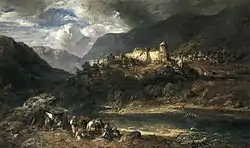
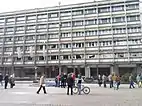
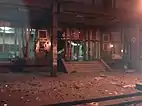
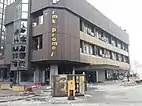

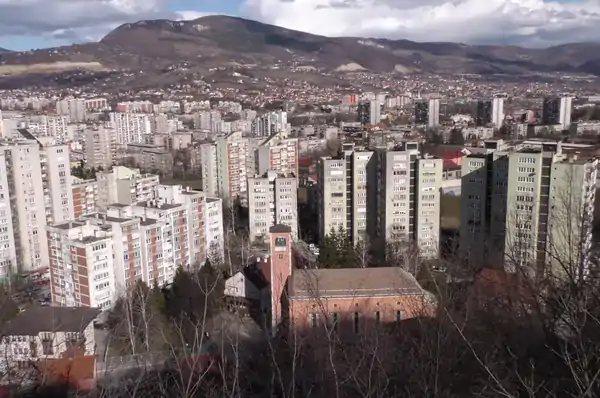
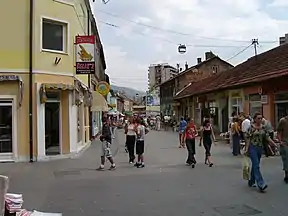
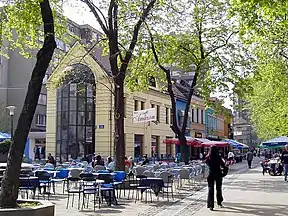
.JPG.webp)
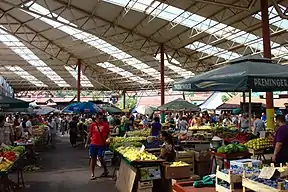



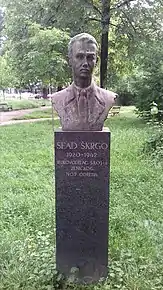
.jpg.webp)

